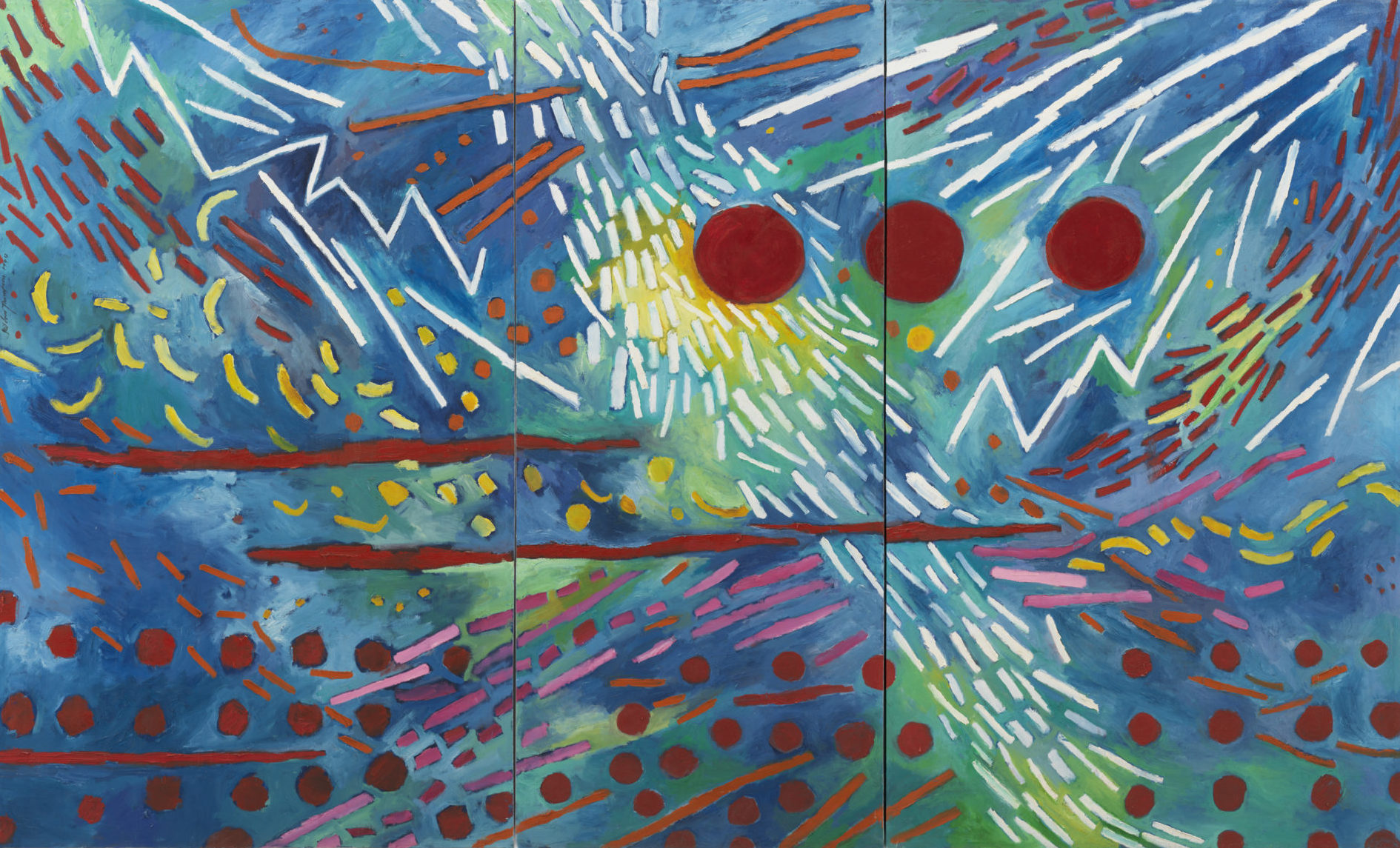Mildred Thompson

Mildred Thompson, Radiation Explorations, 1994, oil on canvas, 81.1 x 133.25 inches [© The Mildred Thompson Estate; courtesy Galerie Lelong & Co., New York]
Mildred Thompson (b. Jacksonville, Florida 1936–2003) led a life of multiplicity. Throughout her prolific career, which spanned more than four decades, she refused to be singularly defined. Thompson explored a plethora of creative avenues as a visual artist, writer, poet, musician, and teacher. Her paintings and works on paper are complex, atmospheric compositions that absorb viewers into a celestial landscape of energetic marks and vibrant hues. During a period when figuration and representation were the primary modes of expression for African American artists, Thompson championed a dynamic abstract language. Never acquiescing under the pressure to make work that could be easily gendered or racialized, Thompson explored themes of the universality that exists among all people. Thompson sought to make visible the invisible, drawing on the rhythmic flow of sound, microscopic elements of nature, and complex structures of the universe to find meaning in the world. In doing so, her legacy also makes visible the wide-ranging breadth of African American artistic production.
Thompson was driven by an insatiable curiosity and a search for understanding. She studied art at Howard University, under the tutelage of James A. Porter, and toward the end of her undergraduate studies she was awarded a scholarship to attend the Skowhegan School of Painting & Sculpture (1956). Thompson spent much of her career as an expatriate, living mostly in Germany under what she described as a “self-imposed exile.” In Germany she expanded her repertoire by experimenting with etching, lithography, and other printmaking media. She honed her artistic practice at the University of Fine Arts Hamburg (1958–1961). After three years, she returned to the states with a large body of work. She settled in New York with hopes of propelling her artistic career forward, but Thompson did not find the same artistic acceptance there that she experienced abroad. Galleries were repeatedly reluctant to exhibit the work of a young black woman, and particularly, one whose work was not centered on her identity or the figure. Faced with this discrimination, Thompson again traveled overseas. She settled in the rural town of Düren, Germany for a decade, and exhibited her work across Europe.
In 1974 Thompson returned to the US and participated in residencies in Tampa, FL, and Washington, DC, returning to Europe, this time working for several years in Paris before settling permanently in Atlanta in 1986. While in Atlanta, she served as an associate editor of ART PAPERS from 1989 to 1997. During that tenure, Thompson conducted interviews with notable artists and reviewed exhibitions. Thompson approached her work for ART PAPERS with the candor and inquisitiveness that characterized her creative curiosity across various modes of output. Just as her language of abstraction in painting illuminates the un-seeable, Thompson’s written contributions to ART PAPERS delve deeply into the interiors of artists’ minds, examining the motivating forces and ideological concerns inherent to their practices.
— Nzinga Simmons
In partnership with the Mildred Thompson Legacy Project, we have re-released select interviews conducted by Thompson during her tenure as an associate editor of ART PAPERS.
Mildred Thompson’s large-scale, interdisciplinary retrospective exhibition, Mildred Thompson: The Atlanta Years, 1986–2003 at Spelman College Museum of Fine Art, features a selection of Thompson’s written work for ART PAPERS alongside paintings and works on paper. The exhibition is on view until December 7, 2019.
Share:
Emma Amos
FROM THE ARCHIVES: Mildred Thompson in conversation with Emma Amos for ART PAPERS March/April 1995.
Guillermo Gomez-Peña & Keith Antar Mason
FROM THE ARCHIVES: Mildred Thompson in conversation with Guillermo Gomez-Peña and Keith Antar Mason for ART PAPERS January/February 1993.
Helmut Middendorf
FROM THE ARCHIVES: Mildred Thompson in conversation with Helmut Middendorf for ART PAPERS March/April 1990.
Lois Mailou Jones
FROM THE ARCHIVES: Mildred Thompson in conversation with Lois Maliou Jones for ART PAPERS September/October 1991.
Wayne Kline
FROM THE ARCHIVES: Mildred Thompson in conversation with Wayne Kline for ART PAPERS March/April 1992.
George Andrews
FROM THE ARCHIVES: Mildred Thompson in conversation with George Andrews for ART PAPERS September/October 1991.
Meredith Monk & Nurit Tilles
FROM THE ARCHIVES: Mildred Thompson in conversation with Meredith Monk and Nurit Tilles for ART PAPERS September/October 1988.
Jörg-Imgo Weber
FROM THE ARCHIVES: Mildred Thompson in conversation with Jörg-Imgo Weber for ART PAPERS March/April 1990.
Valerie Maynard
FROM THE ARCHIVES: Mildred Thompson in conversation with Valerie Maynard for ART PAPERS July/August 1990.
Salomé
FROM THE ARCHIVES: Mildred Thompson in conversation with Salomé for ART PAPERS January/February 1988.
Adrian Piper
FROM THE ARCHIVES: Mildred Thompson in conversation with Adrian Piper for ART PAPERS March/April 1988.